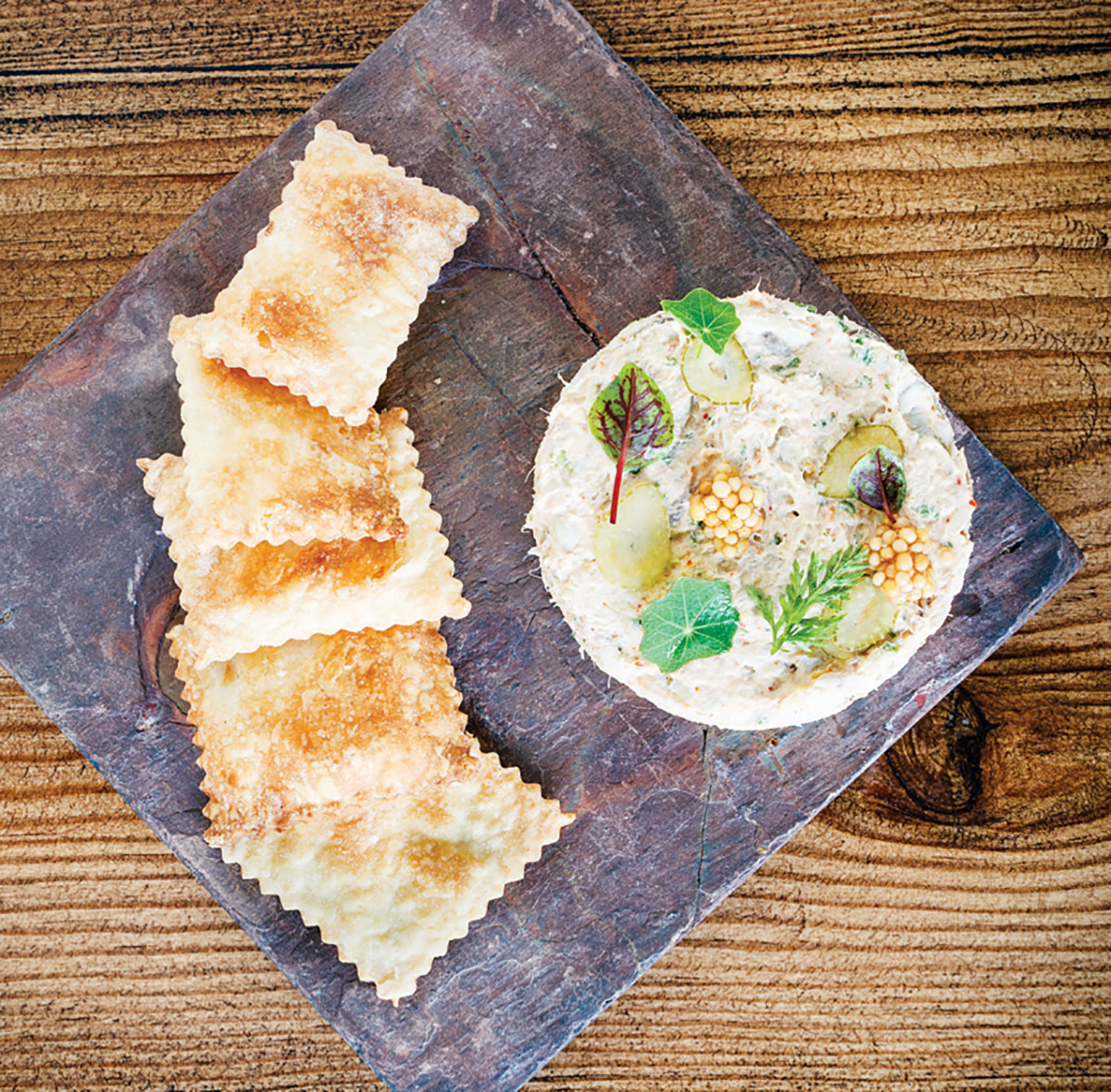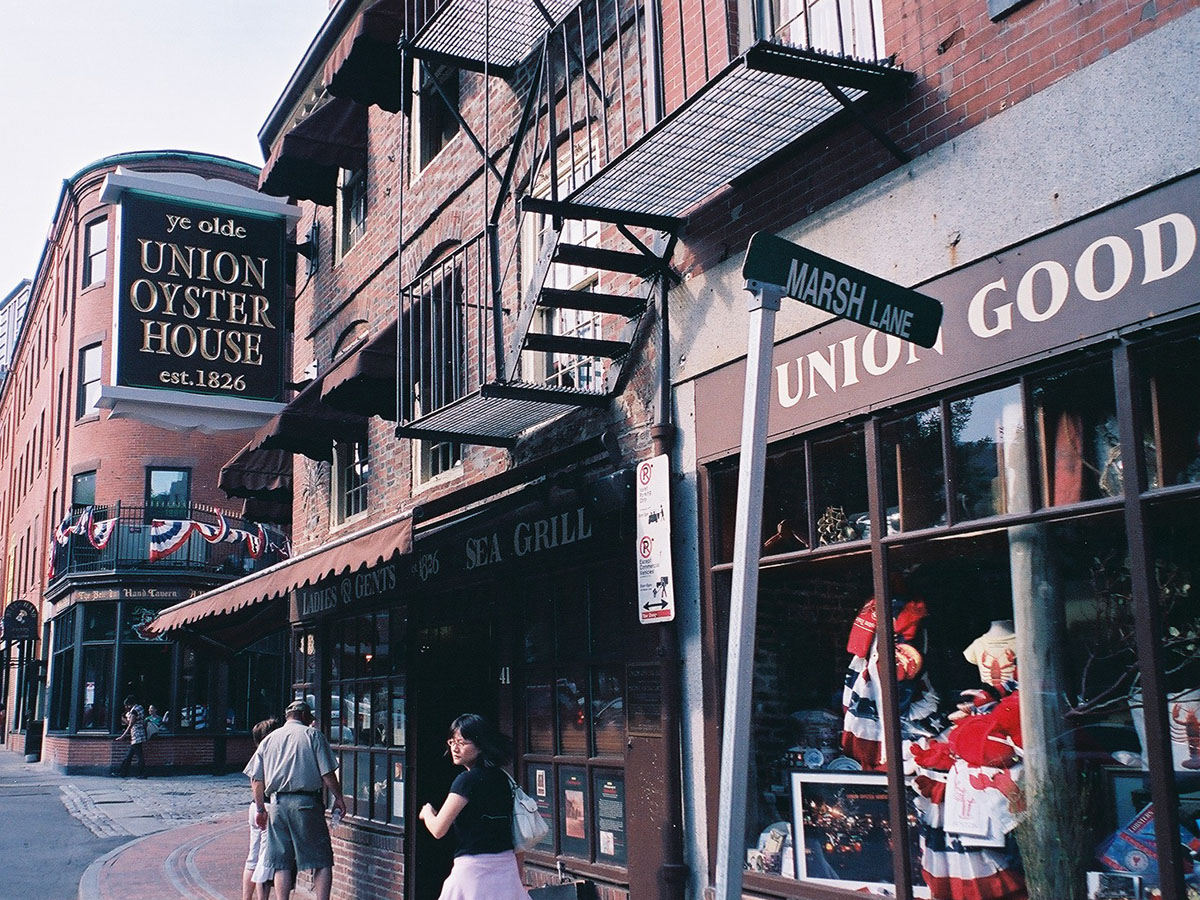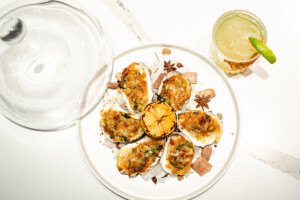Take a Time-Traveling Food Tour with Boston’s Historical Cuisine

Smoked-mackerel pâté with hardtack crackers at Puritan & Company / Photo by Anthony Tieuli for “Restaurant Review: Puritan & Company in Cambridge”
In some parts of the country, a building put up in the 1950s might be considered “old.”Not so in New England, a land littered with 400-year-old architecture. Around here, we have a romance with the past that’s not letting up anytime soon. True, our city is currently gripped in a skyline-redefining frenzy of sleek, emotionless new construction, but despite that—or perhaps precisely because of it—we’re seeing a reverence for bygone eras spilling onto the plates at many of Boston’s most buzzed-about restaurants, and upheld on the menus of venerable favorites. Here’s how to take a time-traveling tour through the city, one bite at a time.
Get Mad About Moxie at Puritan & Company
If you’re going to do some culinary time-traveling, start with Inman Square’s Puritan & Company, who were early adopters of the history-for-dinner trend. “For the first time, a kitchen is entirely inspired by New England ingredients and traditions,” we wrote a few months after its opening in late 2012. “Its goal—to bring a regional style associated with the 18th and 19th centuries forward into the 21st.” As part of that agenda, you can nibble smoked bluefish pâté on traditional hardtack crackers before tucking into Moxie-glazed lamb belly, a nod to the New England tonic first released in 1876 as a nostrum called “Moxie Nerve Food.”
Puritan & Company, 1166 Cambridge St., Cambridge, 617-615-6195, puritancambridge.com.
Try Farmhouse Succotash and Johnny Cakes at The Tap Trailhouse
Back in 2014, The Tap Trailhouse cast aside the old wings-and-suds menu to dedicate itself to the historic trappings of the Faneuil Hall neighborhood, serving up Colonial-era “vittles” like fried smelts, cauldron clam chowder, and craft beer poured from antique musket handles. Sure, you can still get nachos, but they’re topped with New England blue crab. In addition to the creatively anachronistic fusion, you can try the real deal: Their farmhouse succotash—originally a Native American staple—is a dish straight out of the Pilgrims’ cookbook; and while the 18th-century colonists weren’t much for brunch (the term doesn’t show up until 1896 or so), they were well-versed in johnny cakes, which you can order off the Tap Trailhouse’s brunch menu.
The Tap Trailhouse, 19 Union St., Boston; 617-367-9660 or thetaptrailhouse.com.

Union Oyster House photo by slayer on Flickr/Creative Commons
Make Like Daniel Webster and Scarf Down Shellfish at Union Oyster House
Of course, no time-traveling trip to the Faneuil Hall area would be complete without a stop in at Union Oyster House, a Boston fixture (and historic landmark) whose architecture dates back to pre-Revolutionary days and has been serving food since 1826. We may be in the New Golden Age of the Oyster now—but nearly 200 years ago, 19th-century statesman Daniel Webster was having his fill of bivalves at the restaurant’s U-shaped mahogany oyster bar, now called “Webster’s bar.’’
Union Oyster House, 41 Union St., Boston, 617-227-2750, unionoysterhouse.com.
Feast on Lasagna from the Borgia Table at MC Spiedo
Yes, Medieval Manor is headed the way of the dodo, and King Richard’s Faire has evanesced until next fall—but you can still eat like Italian royalty at M.C. Spiedo, located inside the Renaissance Boston Waterfront Hotel in the Seaport. Way better, in fact. You won’t find any novelty turkey mega-legs here: Instead, chefs Mark Gaier and Clark Frasier—famed for pioneering the garden-to-table movement with their restaurant Arrows in Ogunquit—serve up dishes inspired by Old World feasts, including spit-roasted suckling pigs (spiedo is the Italian word for spit), a 16th-century lasagna recipe, salads cribbed from Da Vinci’s notebooks, and an herb-roasted chicken dish that, according to Gaier and Frasier, was served “on December 23, 1326 in Siena to celebrate the knighting of Francesco Bardenelli.”
MC Spiedo, 606 Congress St., Boston, 617-476-5606, mcspiedoboston.com.

Bread at Loyal Nine / Photo courtesy of Loyal Nine
Make a Pilgrimage to Cambridge for House-Made Boston Brown Bread at Loyal Nine
Chef Marc Sheehan has harbored a long fascination for traditional New England foodways, and his Loyal Nine menu embraces them with gusto—from the native periwinkles and whelks, to the patio-grown herbs, to a drinks program highlighting shrubs, a drinking vinegar popular in Colonial tipples. But perhaps especially in baker Adam Ross’s long-fermented breads, which includes none other than iconic Boston brown bread, whose origins stretch back to Puritan days. We found the brown bread especially transcendent topped with “soused” bluefish, which is named after a tradition method of preserving fish in vinegar.
Loyal Nine, 660 Cambridge St., Cambridge, 617-945-2576, loyalninecambridge.com.
Hold Onto Your Fannie Farmer and Order the Mushrooms Under Glass at Kitchen
For those who love to pore over old cookbooks, you’ll be in good company at Kitchen in the South End, which resurrects old recipes from the forgotten past. “Old is new” is their motto, and they launched with dishes culled from the pages of the original 1931 edition of The Joy of Cooking and other classic works. As our reviewer wrote, they “present a kind of cavalcade of American cuisine: western pork and beans; high-style dishes a Vanderbilt would have ordered at Delmonico’s, in New York; the sole meunière that changed Julia Child’s life.” If you want a taste of the early 20th century, go for the mushrooms under glass, popularized by Fannie Farmer in 1918’s The Boston Cooking School Cookbook.
Kitchen Restaurant, 560 Tremont St., Boston, 617-695-1250, kitchenbostonmass.com.
Share a Boston Cream Pie with the Ghosts of Christmas Past at the Omni Parker House
The Parker House singlehandedly lays claim to an awful lot of Boston food history. Back in the day, this culinary juggernaut created the Boston cream pie, invented the Parker House roll, and claims to have coined the term “scrod.” Originally built in 1855, the Parker House was Charles Dickens’ hotel of choice, and it’s where he first recited and performed A Christmas Carol for the Saturday Club nearly 150 years ago. In addition to being very historic, the hotel is also supposedly very haunted.
Omni Parker House, 60 School St. Boston, 617-227-8600, omnihotels.com.
Taste 18th-Century Chocolate at Captain Jackson’s Historic Chocolate Shop
“Look don’t touch” does not apply to Captain Jackson’s in the North End—you’re invited to eat history. Here, “chocolate interpreters” in Colonial garb grind cocoa nibs on a metate to create the thick, strangely spiced confection that used to sate the Founding Fathers’ sweet tooth cravings. You can even take some home with you: Ye olde gift shoppe sells American Heritage-brand wares created by Mars (yes, the same folks who make M&Ms and Twix make historically accurate chocolate—and the story behind it is weirder than you’d think). Turns out, we’re kind of spoiled for choice when it comes to throwback chocolate in the North End; just a short walk away is the Boston Public Market, where Taza’s rustic chocolate, ground in traditional stone molinos, awaits.
Captain Jackson’s Historic Chocolate Shop, The Clough House, 21 Unity St., Boston, 617-523-4848, oldnorth.com/captainjacksons.

Huzzah! Tavern Nights spread / Courtesy photo via Boston Tea Party Ships & Museum
Don Your Tri-Cornered Hat and Revolt Against Sobriety at a Tea Party Museum Tavern Night
December 16 marks the anniversary of the Boston Tea Party, which Fort Point’s Tea Party Museum celebrates with a burst of historical rabble-rousing. But you can stir up trouble with your fellow patriots all year long: Every second and fourth Friday of the month, they invite you to “leave your 21st century troubles and cares behind, grab a mug of ale, and join the Sons and Daughters of Liberty for the best hospitality in all of 18th century Boston.” Your ticket gets you a history lesson wrapped in an evening of Colonial mischief, as you sing tavern songs, eat “Roasted Sweet Meat of Swine,” and guzzle hot buttered rum—Paul Revere’s drink of choice.
Boston Tea Party Ships & Museum, 306 Congress St., Boston, 800-599-8327, bostonteapartyship.com.



